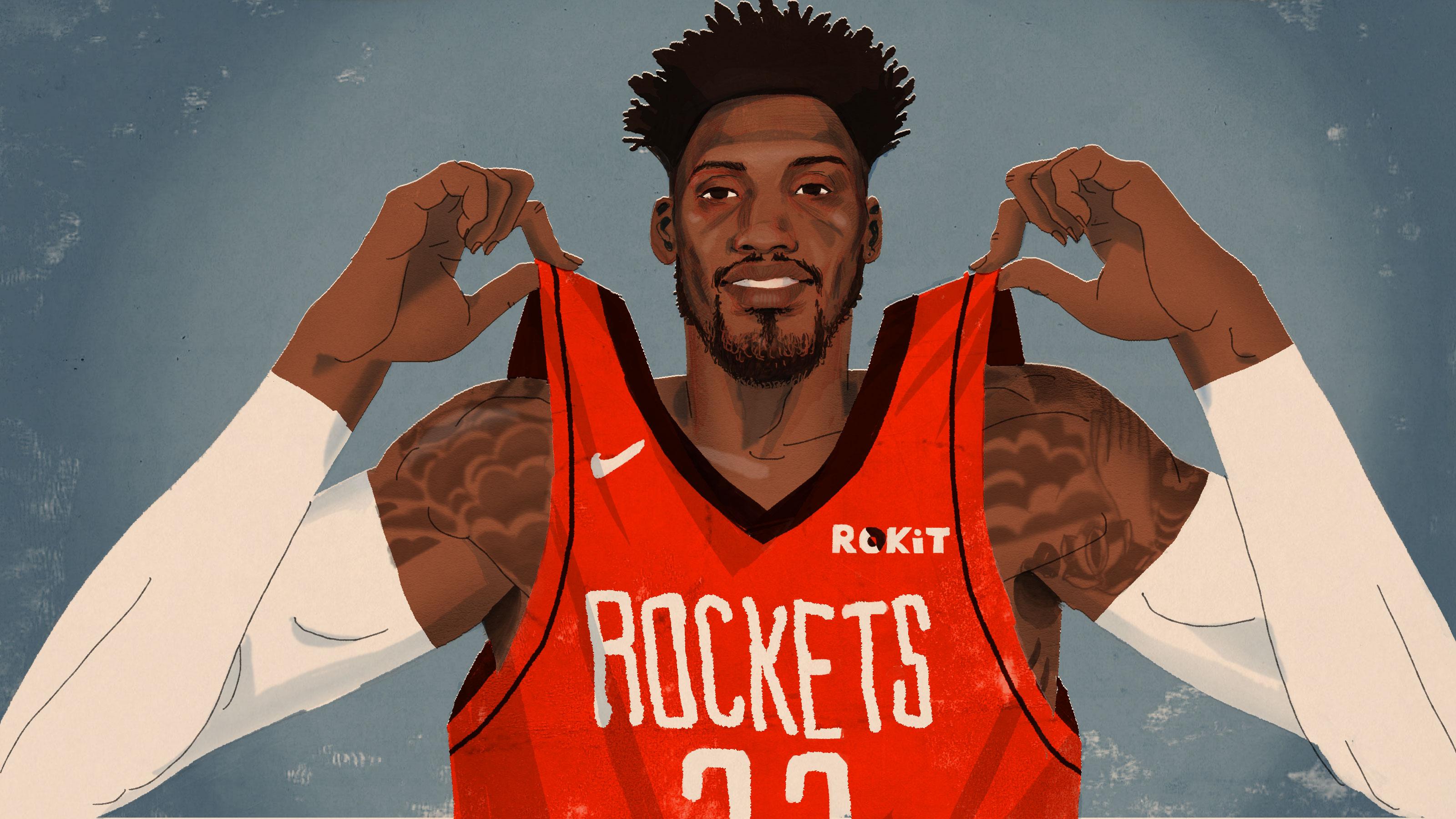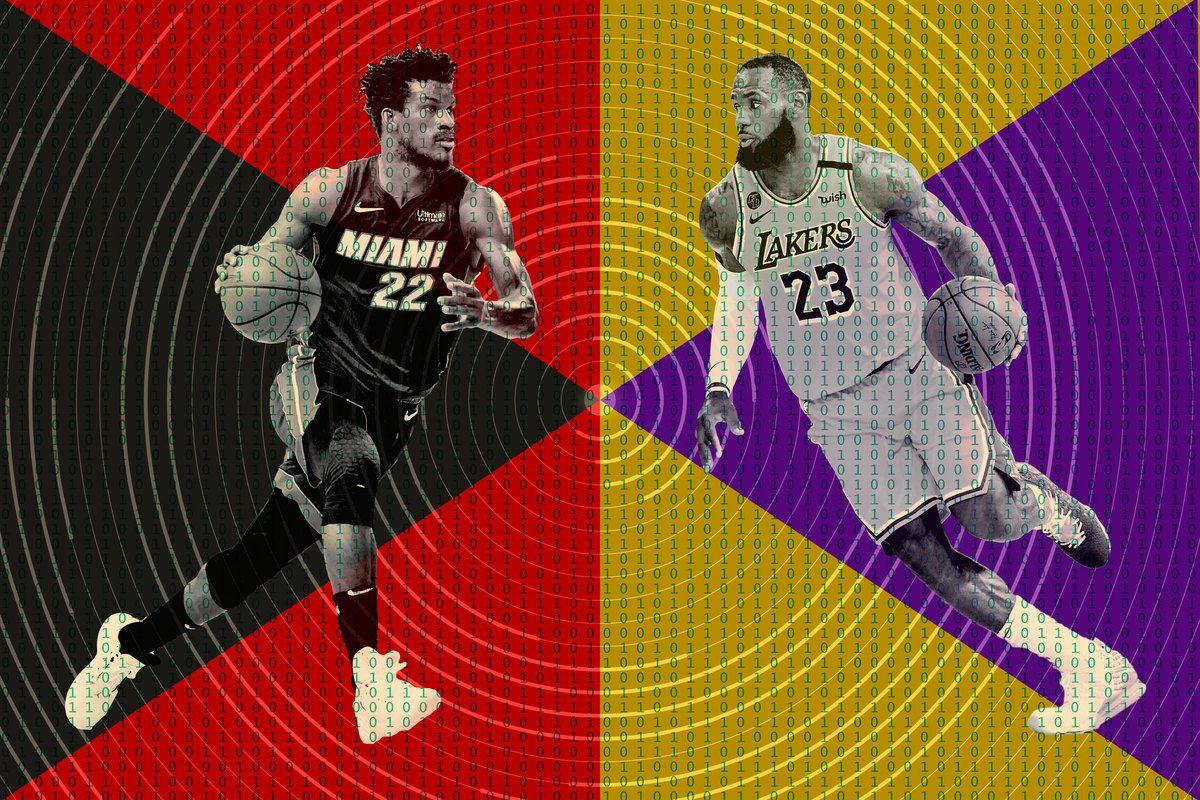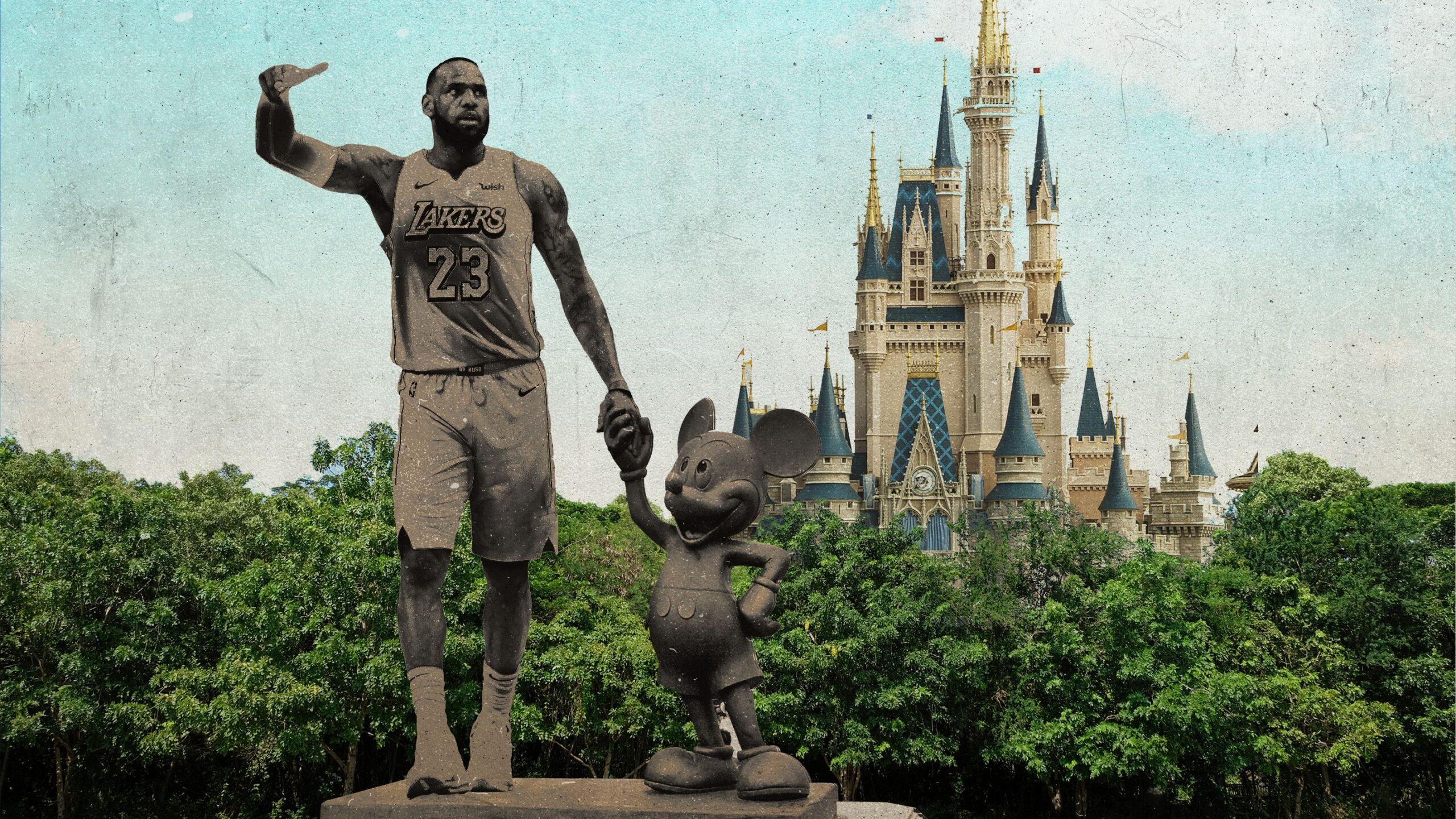In the Middle of a Revolution
The listed center for the NBA bubble’s biggest wild card stands at 6-foot-7. Here’s why the Rockets gave Robert Covington a shot in their 3-point laboratory, and why they brought him back to take their radical style to a whole new level.Every basketball team is slowly dissolving. Whatever it does best will eventually be unwound, bit by bit, by opponent after opponent. The most essential players on the team inch further from their prime, or toward the day they’ll eventually leave. Teams grow stale, or anxious, or agitated. The only real mystery is how long a team can last before it falls apart.
The Rockets have gone to great lengths to stay ahead of that reveal. Over the course of five seasons, Houston organized a team around James Harden and Dwight Howard, streamlined its pick-and-roll by replacing Howard with Clint Capela, brought the offense to balance by adding Chris Paul, transformed that same offense by unleashing Harden in isolation, altered the formula by trading Paul for Russell Westbrook, and—before the suspension of the current season—took the radical step of abandoning the center position as we know it. Capela is gone. In his place, Houston now starts a career small forward in Robert Covington, taking small ball to its logical conclusion.
“Playing five out on offense, spacing, transition—all that has been done before,” Rockets general manager Daryl Morey said a few weeks after the trade. “We’re just gonna do it 48 minutes, and other teams have maybe done it 20 minutes.”
This change comes in service of Harden. The Rockets consider the stewardship of a superstar’s prime years to be a sacred responsibility, likely because they know the difficulties of doing without. Before landing Harden in the fall of 2012, Houston missed the playoffs in three straight seasons despite winning records. His arrival shifted the weight of the entire organization. Houston isn’t just searching for the right players to complement Harden, but the right premise. “The original best way, we thought, to build around James—and it’s still pretty true—is a guy like Dwight, and then a guy like Clint, where you really can’t guard that pick-and-roll with two [defenders],” Morey says. Over time, opponents adjusted by switching the pick-and-roll to take away its natural momentum, or trapping Harden to negate his influence on the way a possession develops. “The big became almost like a double-team escort,” Morey says. The fabric of Houston’s offense, though still one of the most efficient in the league, had begun to fray.
Harden attempted to patch things up where he could. Rather than run the usual pick-and-rolls, he instructed Capela to lurk along the baseline and, most crucially, keep out of his way. Despite those efforts, high-level defensive bigs still found ways to impede Harden’s progress—splitting the distance between Capela and the ball to effectively play both options at once. Favoring smaller lineups with better spacing, Rockets coach Mike D’Antoni sometimes elected to close out games with no center on the floor at all. Trading Capela to the Hawks—and then releasing backup center Isaiah Hartenstein—simply made that arrangement permanent. Covington now stands as the tallest member of Houston’s anarchic starting lineup, measuring all of 6-foot-7.
“Our team is better this way,” D’Antoni says. “If you’re gonna dive in, you might as well go all the way in.”
Houston’s competition in the NBA bubble has seen how dangerous that sense of purpose can be. The downsized, spaced-out Rockets have the firepower to beat anyone—and have already gotten the best of both no. 1 seeds during their time in Orlando. Matching up with this team has become a singular challenge. While in the midst of the best offensive season in NBA history, the Mavericks scored 149 points against Houston and lost. The Rockets as we knew them weren’t consistent enough to be dominant. By making this trade, they chose instead to be disruptive.
Beyond the theory is a considerable undertaking. A team can’t give up this much size without putting itself at a constant disadvantage on the glass. Routine elements of the game have become hard work, requiring constant energy and attention. What ultimately convinced the Rockets to take the plunge was the chance to add Covington. Broadly speaking, Covington is one of the NBA’s preeminent 3-and-D forwards—a valuable distinction in and of itself. Houston’s needs, however, were more precise. If the Rockets were going to contend, they would need an alternative to traditional rim protection. The way Covington roams the floor, leveraging his instincts and agility, made the prospect of full-time small ball a more practical reality. “Rob,” Morey says, “was really the key to unlock it.”
If only the Rockets had realized that six years earlier, when, in their search for role players to flank their emerging superstar, they brought Covington into the NBA only to cut him loose.
Sixty picks had come and gone in the 2013 NBA draft, and none were used to select a fourth-year forward from Tennessee State University. This was a bitter pill. Though he was a borderline prospect recovering from a torn meniscus, Covington held out hope that he’d hear his name called. He had it on good authority that Philadelphia would take him in the second round. The 76ers went in a different direction, or more accurately, several; by the end of the night, Philly had acquired three players in the second round, none of whom are still in the NBA. Before Covington could fully process what had transpired, the Rockets called to offer him a partially guaranteed contract.
“It was unfortunate how the night had went,” Covington says. “But at the end of the day, getting that phone call and just having the opportunity, I knew that was my gateway.” Covington thanked the Rockets with a post to his Instagram, punctuated by six exclamation points.
Sam Hinkie, in the tome announcing his departure as general manager of the Sixers years later, characterized this moment as one of profound regret. Following his eventful first draft in Philadelphia, Hinkie ironed out transactional details, attended to some formalities, and addressed the local media. By the time he returned to the front office, Covington—a prospect he let go undrafted and hoped to sign—had already committed to Houston.
Hinkie himself had just left the Rockets organization, where he worked as a vice president under Morey. Now his former boss had beaten him to the punch. “I shudder, even now, at that ... missed opportunity,” he wrote. Covington played well enough at the Orlando summer league to earn an invite to training camp, and well enough in training camp to secure Houston’s final roster spot. It was understood going in that Covington might not spend much time with the Rockets proper; with playing time at a premium in a veteran rotation, Houston dispatched Covington to its D-League affiliate, the Rio Grande Valley Vipers.
“I didn’t look at it as a demotion,” Covington says. “I looked at it as an opportunity for me to actually get an understanding of the game.” As it turned out, the Vipers were aiming to play a different game than anyone else. Beyond the intended development of players and staff, the Rockets have long used the D-League (since rebranded as the G League) as a farm system for ideas. When Covington arrived, the Vipers’ animating principle was to see how far an offense could go. What would happen if a team shot upward of 50 3-pointers a night? How would the game look if the Vipers pushed the pace beyond what any other team was willing to?
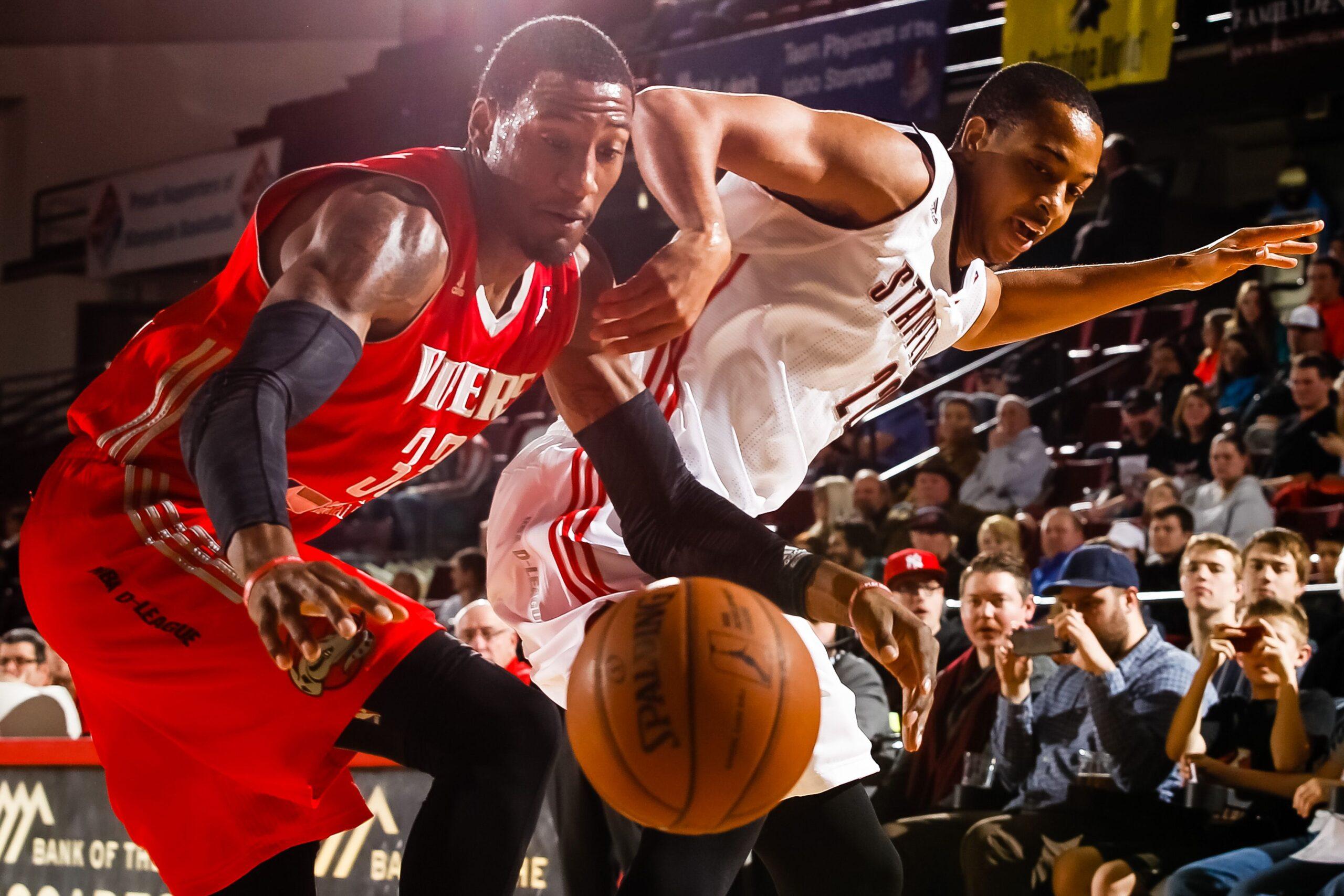
During a preseason tune-up for the Vipers, Isaiah Canaan (a second-round pick on assignment from the Rockets) stepped into an 18-footer off the dribble and nailed it. Rio Grande’s bench applauded in encouragement, until head coach Nevada Smith whipped around. “We don’t clap for that!” he mock-scolded, cracking up the Vipers. Players bought in quickly. The result was a grand experiment—what Kevin Pelton of ESPN.com called “the most extreme professional basketball in America.” In all, the Vipers would take 46.9 percent of their shots from beyond the arc, and attempt almost 500 more 3-pointers than any other team in the league. The Rockets, who were the most ambitious 3-point shooting team in the NBA at that time, took just 33 percent of their shots from that distance.
Covington found his calling by bombing away, and became the D-League’s Rookie of the Year in the process. It was strange at first, Covington says, to shoot so freely. Yet in time, he began spotting up a foot and a half beyond the arc, just to find cleaner looks—years before players in the NBA would do the same. “His shooting ability was, from deep, effortless,” Smith says.
The best way for a young player to build a rhythm is to get up shots against real defenses at game speed, and with the Vipers, there were always so many shots to go around. “The more you play, the more reps you get, the more confidence you get,” says Nuggets guard Troy Daniels, who led that Vipers team in 3-point attempts with 12.5 per game. (The only NBA player to ever take that many 3s, on average, is Harden.) It was a thrilling way to improve and a direct line to team chemistry. There is a camaraderie that comes with breaking the rules; nonconformity, oddly enough, has a way of bonding people together. “That’s what it was all about,” Covington says, reminiscing about team dinners and trips to the bowling alley. Those with the Vipers remember him as a talented prospect who always seemed to be in a good mood—a rarity in a league predicated on the desire to be somewhere else.
For Covington, the assignment was an audition. “What’s done in the dark will come to light,” he explains, repurposing scripture. “No matter what. You’re down there in the D-League, and there’s still teams up here watching.”
Over the course of the 2013-14 season, the Rockets called Covington up from the Vipers on six separate occasions, in some cases for only a day or two. He logged a total of 34 minutes for Houston on those trips—the equivalent of one night’s work for an NBA regular, doled out in scraps over seven games. Those 34 minutes would be the extent of Covington’s official contributions during his first stint with the Rockets.
Houston waived Covington on October 27, 2014, though by that point he already had been away from the team for weeks courting offers to play abroad. “Unfortunately, he ended up being cut because he just got caught in a numbers game,” Morey says, “which is obviously a mistake by me.” In Morey’s defense, Covington was by no means an obvious choice to stick with a clear playoff team at that stage in his career. Where the Vipers found valuable stretch in Covington’s game, NBA scouts saw a forward without a positional fit, years before switching defenses made that a virtue. Covington was only a fledgling defender at this stage; Chris Patrick, who represented Covington, admitted that there was doubt even within his agency as to whether Covington could cut it in the league as a perimeter player. Upon his release, no other team claimed Covington on waivers.
Yet what was explicable in the moment proved costly in retrospect. Among the players Houston chose to roster over Covington: Kostas Papanikolaou, who flamed out of the NBA after two years and now plays for Olympiacos; Tarik Black, whom the Rockets waived two months into the season; second-round pick Nick Johnson, who now plays in the Turkish Super League; Joey Dorsey, who would play his last NBA basketball that season; and veteran Francisco García, who was released by December and is now retired.
Without a contract to anchor him, Covington nearly left the NBA—reportedly to join EuroLeague stalwart CSKA Moscow. “It was an opportunity where I had an overseas gig that was kinda hard to turn down, but it was like taking a gamble on yourself,” Covington says. “Do you believe in yourself enough to give up something where you can be secure? Or not?” Covington chose to take a financial risk to remain stateside. Validation came quickly. After the Sixers lost the first nine games of their season, they signed Covington to help space the floor. Hinkie finally got his man. Within a few years, the regret of missing out on Covington would come all the way back to Morey and the Rockets.
“We should have had time for him,” Morey laments. “Hindsight is 20/20, but we didn’t think he was going to develop here, either. We just didn’t see a path for him to play the minutes he ended up playing in Philly.”
One of Covington’s best games in the NBA came on a return trip to Houston in 2015: 28 points (then a career high) with six made 3-pointers (then tying a career high) and eight steals (still a career high). “I heard from a lot of people that game,” Covington says. “Just about the evolution of what I’ve been able to do.” He insists that his performance wasn’t pointed, though he doesn’t deny it was satisfying—in part because the Rockets knew just how far he had come. “It was a testament to see the people that I started with here recognize that I’ve been able to prosper,” he says.
The Rockets spent years attempting to rectify their mistake. According to Morey, Houston tried to trade for Covington once he established himself in Philly; attempted to broaden trade talks between the Timberwolves and Sixers last season into a three-team deal, if not to get Jimmy Butler then to add Covington; tried to negotiate a trade for Covington once he landed in Minnesota; and tried again after Gersson Rosas, a longtime Morey lieutenant, was hired as Minnesota’s president of basketball operations. There was obvious appeal in a two-way, floor-spacing wing on one of the most team-friendly contracts in the league. What made the process more challenging was that all three of the teams in Covington’s orbit—the Rockets, Sixers, and Wolves—were acutely aware of just how good he was.
“It’s when you have a mismatch of how good teams think someone is—that’s when it gets easier,” Morey says. “But there is a second scenario where it gets easier, and that’s what came up this time: when a team is at a different phase of their development.” Even then, it took a four-team, 12-player deal—one of the largest in league history—to finally bring Covington back to Houston. It cost the Rockets a productive center, a first-round pick, and two other players to correct a marginal roster decision from half a decade ago.
Houston sustains its roster through a culture of recursion. Although Harden is entrenched at the center of everything, the role players around him come, go, and come back. Trevor Ariza signed with the Rockets in 2009, was traded away in 2010, and traded back in 2014. Jeremy Lin was signed and waived in 2011, only to be signed again—post-Linsanity—in 2012. Covington comes from a long line of born-again Rockets, from Ryan Anderson to Aaron Brooks to fellow Viper alum Isaiah Canaan. Just before flying to Orlando for the NBA’s restart, Houston even brought back Luc Mbah a Moute, a reserve from the 2017-18 team, for old times’ sake. Déjà vu has become a part of the team’s design. This season alone, the Rockets have had six players on their roster (Covington, Anderson, Mbah a Moute, Gerald Green, Bruno Caboclo, and DeMarre Carroll) brought back after a previous stint.
On some level, these are matters of taste. Houston has long pursued players of very specific archetypes, filtered by whatever data was deemed pertinent. But realistically, there are only so many spot-shooting point guards and rangy wings to be found on budget salaries; if you split the league into the same buckets, year after year, you wind up rifling through the same collections of players.
“You never realize that a team can be a trendsetter for how the NBA transitions.”
“I do think, philosophically, we tend to take a lot of bets,” Morey says. “If you take a lot of bets, you end up having to waive a lot of bets.” (One such wager from Rockets training camp: Anthony Bennett, who was selected first the year Covington went undrafted. Bennett did not make the regular-season roster, and never appeared in the preseason due to a knee injury.) Leslie Alexander, the Rockets’ previous governor, was often irritated when a player Houston cut would go on to succeed somewhere else. Morey offered a solution: “We can just stop bringing in good players,” he said. “Then, we’ll never waive a good one.”
Basketball operations in Houston have been run according to Morey’s sensibilities since 2007, uncommon longevity in an industry where general managers are fired for reasons ranging from roster mismanagement to social media faux pas. With Houston’s stability comes a consistency in organizational values. Inevitably, the Rockets will trade and release players as a cost of doing business. “But the skill set that put them on our radar is still there,” Morey says. “So then when they develop on another team, we’re often trying to get them.”
As those players evolve, so too does the framework in Houston. There was a time when the Rockets might not have traded Capela for Covington—when their reliance on pick-and-roll basketball eclipsed their curiosity in spacing the floor to its fullest. Yet with the propulsion of Harden’s creativity, Westbrook’s force, and D’Antoni’s ideology, Houston pushed boldly into the future by re-acquiring a player it had once let go.
After the trade, Covington was relieved to see so many familiar faces at the Toyota Center. There is, however, one critical difference in the franchise between then and now: After using the Vipers to push the limits of modern basketball, the Rockets eventually became them. What was once revolutionary has now become the organizational standard. “At the time,” Smith says of his run in the Rio Grande Valley, “we were looked at like we were nuts. We were ruining the game.” Now, the Rockets take an even greater portion of their shot attempts from beyond the arc (49.7 percent) than the Vipers ever did. The experimental went mainstream.
“Houston,” Daniels says, “was using us like guinea pigs.”
The Vipers played Covington and James Johnson (a 6-foot-7 forward now with the Timberwolves) together as an interchangeable 4 and 5, an echo of the kind of small ball Houston plays now. On defense, the Rockets asked the Vipers to experiment with switching all ball screens—a full season before the Warriors won their first title with that very strategy. “I think they just wanted to see what would happen,” Smith says. Switching has since become Houston’s default coverage, affording Covington even more opportunity to shape every defensive possession. “I sit up here and see how everything unfolds, and how the game changes,” Covington says. “You never realize that a team can be a trendsetter for how the NBA transitions.”
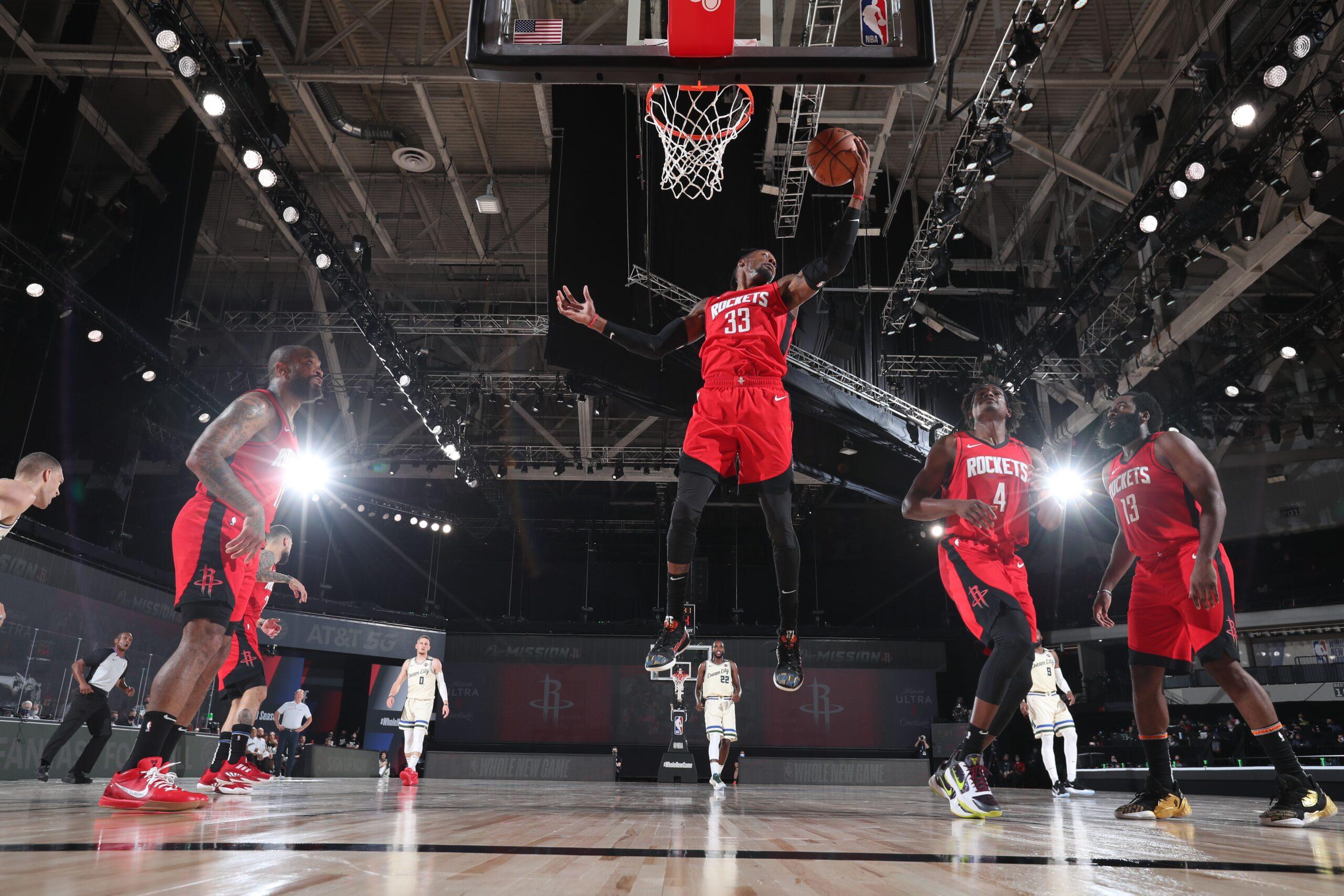
The progression of the NBA always comes down to the prioritization of certain skill sets over others. Houston made P.J. Tucker, a 6-foot-5 brick wall, the shortest starting center in the NBA because it values the breadth of opponents he can cover. Switching on defense, however, is viable only because Harden, Westbrook, and Eric Gordon are utterly resistant to post-ups. “We have a strange team,” D’Antoni says. Covington is a bit strange, too, in all the best ways. Throughout his career, he has consistently registered as one of the NBA’s top shot-blocking wings, according to data from Cleaning the Glass. Now he’s a full-fledged rim protector, providing air support in coordination with Tucker’s road blocks. Since Covington joined the Rockets, the only players to block more shots per game (2.2) are Hassan Whiteside, Brook Lopez, and Anthony Davis—each a monolith towering over the court.
“I think we all have to remember he was a college 4-man in his former life, and so guarding interior players isn’t that foreign to him,” Sixers coach Brett Brown said in 2015. “His length, his 7-2 wingspan allows him to do some things that his weight may contradict.” Brown became a voice of moderation for Covington, one essential to his development as a player. (He also referred to the Vipers, accurately, as a “science project.”) It was in Philadelphia that Covington learned to hone his instincts on defense into something more adaptable. Houston, in admiration of Covington’s full defensive range, now dreams even bigger.
The trade itself was an admission: that the existing formula, while effective to a point, wasn’t stable enough to withstand the turbulence of a long playoff run. Some teams would have tinkered around the edges of their roster in denial of that fact. Houston took it as grounds to abandon the most conventional aspect of its lineup. While other contenders physically overwhelm their opponents, the Rockets now lean on coercion. They want opponents to post them up—to step outside their carefully structured offenses, their working chemistry, their natural order. Through the power of suggestion, Houston can coax Milwaukee into feeding Lopez on the block rather than set up Giannis Antetokounmpo on the move. Or, if the Rockets play fast enough and shoot well enough, some opponents will follow them into the small-ball wilderness, only without the benefit of a roster tailored to its demands.
“That’s the point,” Harden explains. Rather than labor to win the game in front of them, Houston changes the way a game is played. The house style will not budge; this is a club so committed to playing small that 37-year-old Tyson Chandler, the only remaining center on the roster, now wears his nose ring on the bench. Competing against the Rockets means meeting them where they live. “Most teams have traditional centers and 7-footers,” Harden says. “We don’t. So we have to use our quickness and things to our advantage to help us.”
The goal in bringing Covington back wasn’t to transform the Rockets. It was to allow them to be more like themselves. One of the fastest teams in the NBA now aspires to play even faster. An offense devoted to its spacing will stretch the geometry even farther. Westbrook, a former MVP and eight-time All-NBA selection, has never been as efficient as when he plays with Covington.
This is the kind of player who makes superstars better, even before fully understanding the particulars of his job. By the time the season was suspended, Covington had been with the Rockets for roughly a month. One game blurred into the next, and one road trip into another. Practices were few. “I didn’t know too much,” Covington admits. “I was just out there playing and being guided.” The strange new reality of the NBA’s restart has given player and team another chance at a proper introduction. In the absence of the NBA’s regularly scheduled programming, Covington was finally able to comb through the film of every game he had played with the Rockets. What struck him was the shape of things—how far opponents had to scramble just to contest Houston’s shooters, and the way defenses hollowed out the lane for Harden and Westbrook once they were scared into staying home.
“I never got to sit back and really watch what other people saw,” he says. He never got the chance to see his own impact in action. When an NBA team makes a move in the middle of the season, it sacrifices a degree of continuity for a more informed attempt to improve its roster. The league’s unexpected hiatus seems to have split the difference. Covington wasn’t traded to the Rockets until February, but he still managed to join the team for training camp—this time in Orlando.
Under these circumstances, every practice, scrimmage, and seeding game matters. Houston organizes its offense into series rather than sets, relying on the players to suss out their options and find their spacing as they go. The only way for Covington to really find the flow is to live in it a while. Before the break, lineups featuring Covington, Harden, Westbrook, and Tucker were already drubbing opponents by 9.3 points per 100 possessions. How dangerous could they be when one of those core players is working off more than intuition?
Everything about the Rockets’ new resolution is wildly ambitious. At its core, it challenges the assumptions behind what makes a good offense, a good defense, and a good center. It asks guards and wings to replicate an entire position by committee. “We’ve gotta be mean,” Westbrook said following a win over the Celtics back in February. “We’ve gotta go get loose balls. We’ve gotta go rebound. We’ve gotta help each other out.” The Rockets have to do so much just to manage the game’s most basic logistics. When they do, they reach a level of basketball that is close to unassailable. When they don’t, their ambition becomes an anchor, all clever plans and dead weight. That kind of polarity comes with any attempt to break the game. One could argue it’s the point. Follow the Rockets’ experiment all the way to the end, and this is where it leads: to a style unlike anything else in the basketball landscape, with no conceivable middle ground.
“You already started this,” Covington says of his once and current franchise. “So why not finish it?”
